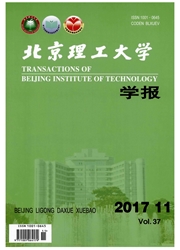

 中文摘要:
中文摘要:
以乙酸锌和氢氧化锂为原料,以无水乙醇为溶剂,采用微波辅助溶胶-凝胶法一步制备了纳米ZnO,用X射线衍射、紫外-可见吸收光谱、电子显微镜和电子能谱对其进行了表征.用紫外光作为光源,一定浓度的活性艳蓝为光催化反应模型污染物,研究了在不同反应时间下微波辐射合成的ZnO光催化性能并与传统溶胶-凝胶法合成的纯氧化锌作比较.结果表明,采用微波法合成的ZnO吸收边蓝移,粒径变小,光催化活性提高;微波辐射30min合成的ZnO光催化性能最好,当催化剂用量为10mg,对质量浓度为20mg/L的活性艳蓝溶液100mL的降解率40min达到90%.
 英文摘要:
英文摘要:
To prepare nano-size ZnO,the zinc acetate and lithium hydroxide was used as raw material and ethanol as the solvent.The sol-gel method supplemented with microwave radiation was adopted.The samples were characterized by powder X-ray diffraction,UV-Vis spectroscopy,energy dispersive X-ray spectrum and electron microscopy.Under the condition of different microwave radiating times,the photocatalytic performance of prepared ZnO samples was studied using UV light as illumination device and XB-R as stimulant pollutant.The characterization and catalytic activities of ZnO prepared with microwave method are compared with that of one prepared using traditional sol-gel method.The results indicate that microwave synthesized ZnO has a smaller particle size and better photocatalytic activity than traditionally prepared ZnO.Sample with 30 minutes microwave radiation has the best performance.Its degradation ratio could reach 90 percent when 100 mL XB-R with the density 20 mg/L and 10 mg nano-size ZnO is irradiated under UV light for 40 minutes.
 同期刊论文项目
同期刊论文项目
 同项目期刊论文
同项目期刊论文
 Kinetics of Heterogeneous Reaction of Ozone with Linoleic Acid and its Dependence on Temperature, Ph
Kinetics of Heterogeneous Reaction of Ozone with Linoleic Acid and its Dependence on Temperature, Ph Probing the Time Scale for Bulk Equilibration and Mass Transport of Water in Amorphous Inorganic Aer
Probing the Time Scale for Bulk Equilibration and Mass Transport of Water in Amorphous Inorganic Aer Investigation of Selectivity over HDS Catalysts by in situ IR Spectra of Adsorbed CO and Molecular S
Investigation of Selectivity over HDS Catalysts by in situ IR Spectra of Adsorbed CO and Molecular S Confocal Raman Spectroscopy Studies on the Interactions between NH4+, NO3- and H2O in Supersaturated
Confocal Raman Spectroscopy Studies on the Interactions between NH4+, NO3- and H2O in Supersaturated Raman Spectral Investigations on the Phase Transition Behaviors of MgSO(4) center dot 7H(2)O Crystal
Raman Spectral Investigations on the Phase Transition Behaviors of MgSO(4) center dot 7H(2)O Crystal Measurement of the association constants through micro-Raman spectra of supersaturated lithium perch
Measurement of the association constants through micro-Raman spectra of supersaturated lithium perch First-principles study of dopants and defects in S-doped ZnO and its effect on photocatalytic activi
First-principles study of dopants and defects in S-doped ZnO and its effect on photocatalytic activi Measurements of the Equilibrium Size of Supersaturated Aqueous Sodium Chloride Droplets at Low Relat
Measurements of the Equilibrium Size of Supersaturated Aqueous Sodium Chloride Droplets at Low Relat Fabrication of superhydrophobic surfaces on zinc substrates and their application as effective corro
Fabrication of superhydrophobic surfaces on zinc substrates and their application as effective corro One-step controllable fabrication of superhydrophobic surfaces with special composite structure on z
One-step controllable fabrication of superhydrophobic surfaces with special composite structure on z coordinate space translation technique for simulation of electronic process in the ion-atom collisio
coordinate space translation technique for simulation of electronic process in the ion-atom collisio Drawing Out the Structural Information About the First Hydration Layer of the Isolated Cl - Anion Th
Drawing Out the Structural Information About the First Hydration Layer of the Isolated Cl - Anion Th Adsorption and Desorption Kinetics of Water in Lysozyme Crystal Investigated by Confocal Raman Spect
Adsorption and Desorption Kinetics of Water in Lysozyme Crystal Investigated by Confocal Raman Spect Direct Comparison of the Hygroscopic Properties of Ammonium Sulfate and Sodium Chloride Aerosol at R
Direct Comparison of the Hygroscopic Properties of Ammonium Sulfate and Sodium Chloride Aerosol at R Observation of the Crystallization and Supersaturation of Mixed Component NaNO(3)-Na(2)SO(4) Droplet
Observation of the Crystallization and Supersaturation of Mixed Component NaNO(3)-Na(2)SO(4) Droplet Effect of Alumina Supports on the Formation of Active Phase of Selective Hydrodesulfurization Cataly
Effect of Alumina Supports on the Formation of Active Phase of Selective Hydrodesulfurization Cataly Investigation on the active phase of CoMo catalyst for selective HDS by low temperature in situ FT-I
Investigation on the active phase of CoMo catalyst for selective HDS by low temperature in situ FT-I Preliminary Assessment of Evaporating Supersaturated MgSO4 Droplet at Low Relative Humidity with Cav
Preliminary Assessment of Evaporating Supersaturated MgSO4 Droplet at Low Relative Humidity with Cav Synthesis With Microwave-assisted Sol-gel Method and Photocatalytic Activity of Quantum-sized TiO2 U
Synthesis With Microwave-assisted Sol-gel Method and Photocatalytic Activity of Quantum-sized TiO2 U Photocatalytic degradation in aqueous solution using quantum-sized ZnO particles supported on sepiol
Photocatalytic degradation in aqueous solution using quantum-sized ZnO particles supported on sepiol Suppression of NaNO3 Crystal Nucleation by Glycerol: Micro-Raman Observation on the Efflorescence Pr
Suppression of NaNO3 Crystal Nucleation by Glycerol: Micro-Raman Observation on the Efflorescence Pr In-situ confocal Raman observation of structural changes of insulin crystals in sequential dehydrati
In-situ confocal Raman observation of structural changes of insulin crystals in sequential dehydrati Intermolecular Vibration Coupling between Libration of Water and nu(2)-SOH for Clusters HSO4-(H2O)(n
Intermolecular Vibration Coupling between Libration of Water and nu(2)-SOH for Clusters HSO4-(H2O)(n Micro-Raman Observation on the HPO42- Association Structures in an Individual Dipotassium Hydrogen P
Micro-Raman Observation on the HPO42- Association Structures in an Individual Dipotassium Hydrogen P Geometries, stability and aromaticity of Al2P22(, [M(Al2P2)]((M=Li, Na, K, Cu) and N(Al2P2) (N=Be, M
Geometries, stability and aromaticity of Al2P22(, [M(Al2P2)]((M=Li, Na, K, Cu) and N(Al2P2) (N=Be, M Structures and aromaticity of the planar B2XY (X = N, P and Y = O, S, Se)
and Al2MN (M = C, Si, Ge a
Structures and aromaticity of the planar B2XY (X = N, P and Y = O, S, Se)
and Al2MN (M = C, Si, Ge a 期刊信息
期刊信息
